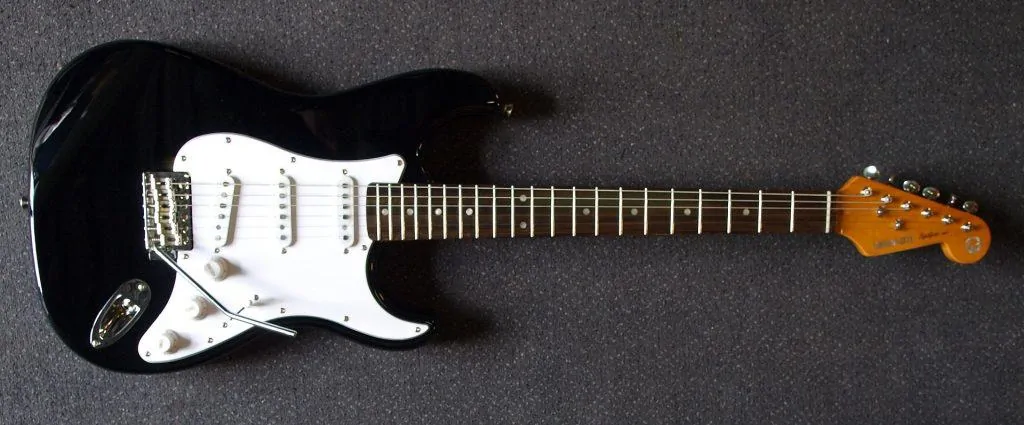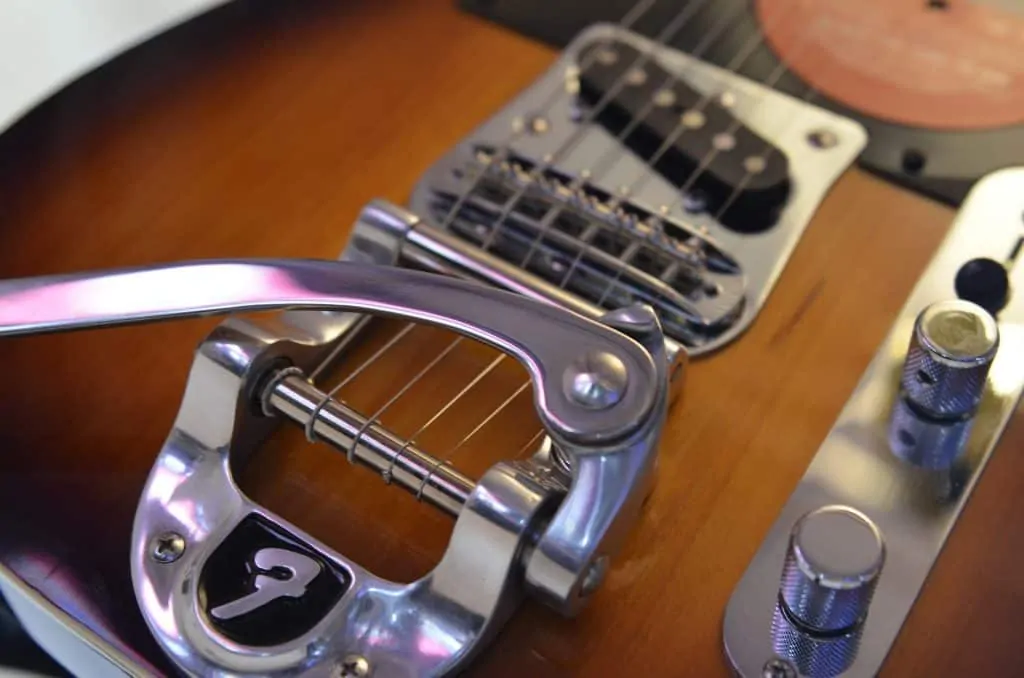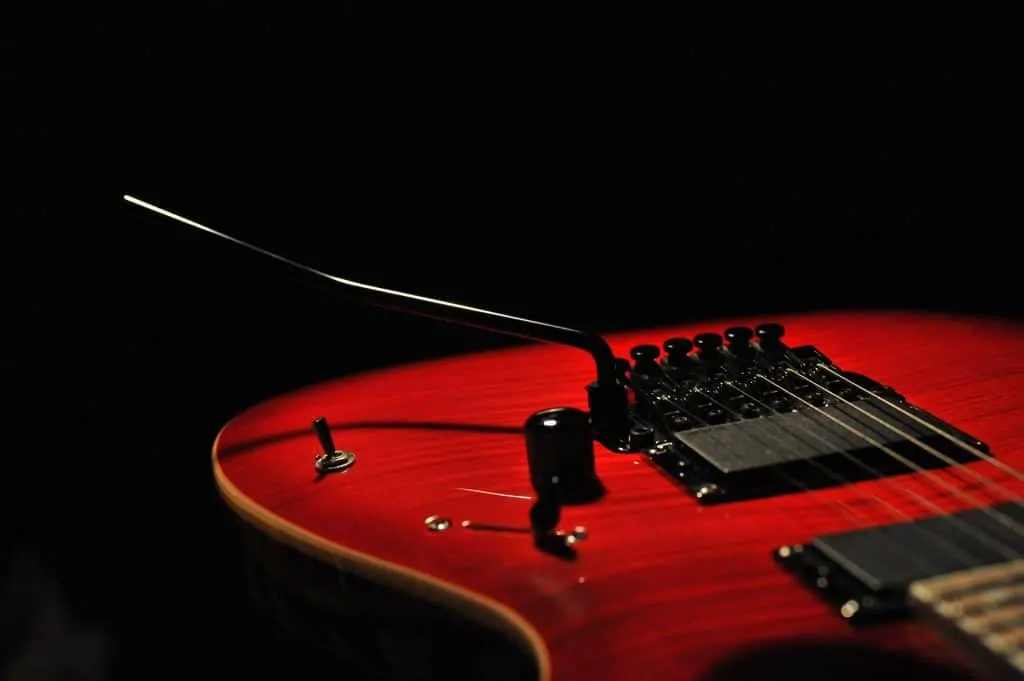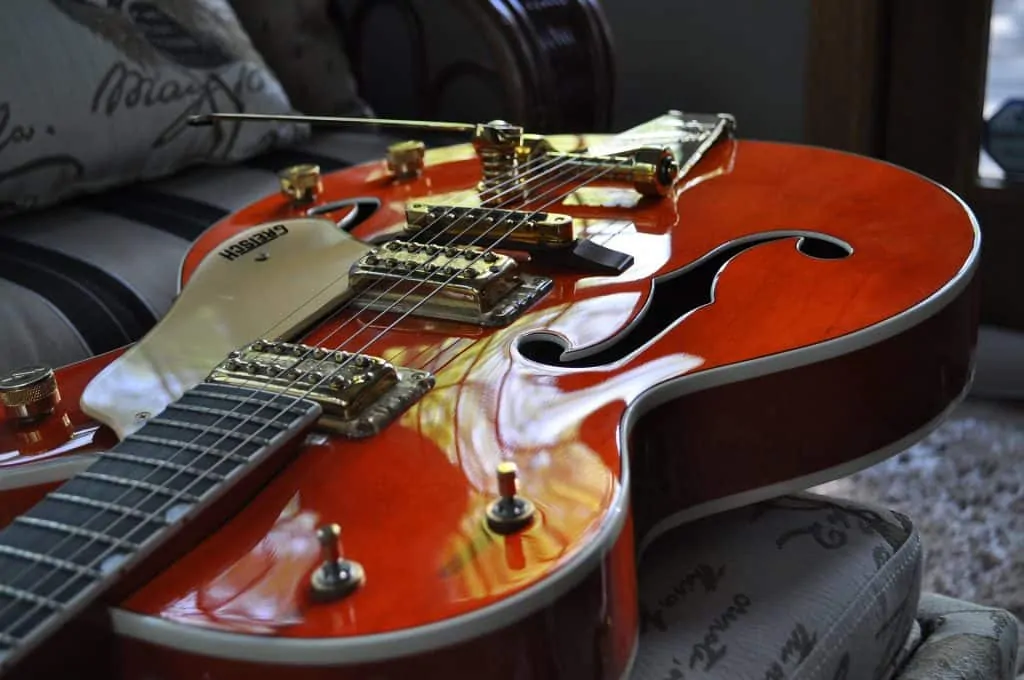The vibrato bar goes by many names: Whammy bar, tremolo bar, vibrato arm, Bigsby arm, even “floating synchronized tremolo”! Whatever you call it, the vibrato bar is a common feature on myriad different guitar models. However, many players only use the vibrato sparingly or don’t know how to properly use it at all.
If you don’t know how to generate a good sound with your vibrato bar, or struggle to time up your vibrato correctly, read through this guide to find out how to improve your playing. While it may seem like a small factor, properly using the vibrato bar can lead to massive improvements in your tone and feel.
Vibrato bars come in many different shapes and styles. Bigsby-style vibrato units are often fixed to Fender Telecasters like this one above.
Contents
What is a Vibrato Bar?
Before discussing more advanced techniques with the vibrato bar, it’s important to explain the tool’s basic capabilities for beginners. As we’ll explain later, there are multiple different types of vibrato arms; each specific type has its own features and quirks. For now, let’s focus on the basic components and terminology.
Vibrato bars are always found at the bridge of an instrument. The system connects with the stoptail on the guitar to work effectively. Some vibrato bars (like the ones found on Fender Stratocasters, for example) actually incorporate the guitar’s bridge into the vibrato system design for a more streamlined appearance.
Every guitar has a fixed scale length — that is, the distance from the bridge at one end of the guitar to the nut at the other. The strings are held at tension for the length of the scale by the guitar’s stoptail (behind the bridge) and the tuning pegs (on the headstock).
When that tension changes, the string’s pitch will change, forcing you to re-calibrate the tension at the tuning peg. A decrease in tension will lower the pitch, while an increase in string tension will raise it — the slow decrease in tension is why guitars left alone for long periods of time may go out of tune.
For long-term adjustments (i.e., to bring a string back to pitch after it’s fallen out of tune), it’s easiest to shorten the string length and adjust the tension via the tuning pegs. However, the string length and tension can also be adjusted from the other end of the guitar by moving the stoptail.
Vibrato systems are effectively moving tailpieces. When you push or pull the vibrato bar, you tilt the tailpiece slightly up or down, which changes the pitch of whatever notes you play. Repeated heavy use of the vibrato can slightly alter the resting string length and tension — that’s why your guitar may go out of tune after you wail on the whammy bar.
Different vibrato systems allow for a different degree of movement in the tailpiece, which can in turn permit a different degree of pitch change. Certain vibratos only allow the player to push the bar downward, which lowers the pitch of the note, and cannot raise the pitch.
Vibrato systems are often incorrectly referred to as tremolo systems, or tremolo arms. Though they can sound similar in certain cases, vibrato units produce a much different effect than tremolo effects in amps or pedals you’d find on pedalboards. Technically speaking, a tremolo effect on guitar is a rapid modulation in volume. Vibrato systems only change a note’s pitch and don’t affect the volume.
Many semi-hollow guitars, like this Ibanez model, come outfitted with Bigsby-style vibrato systems.
Types of Vibrato Bars
Though they share the same underlying concept, vibrato systems come in many different shapes and styles. Some are better suited for certain styles of music than others — if you’re looking to outfit your guitar with a vibrato bar, pay attention to make sure you pick the right one for your playing style.
The Bigsby vibrato arm was one of the first mass-market vibrato systems to appear for the electric guitar. These units can be found on plenty of classic guitar models, from Gibson Les Pauls and ES-335s to Fender Telecasters and Gretsch hollow-body axes. They’re prized for their smooth, silky operation, easy feel for the player, and good tuning stability.
In terms of sound, Bigsby vibrato arms excel at providing rounded dips and swoops within a more reasonable range. Players who prefer to use understated, subtle 12-bar blues vibrato or employ extended, drawn-out bends will love Bigsby units. They’re also noted for their precision; Bigsby units make it easy to land exactly on a different note when changing pitch and avoid out-of-tune sounds.
However, they offer a more limited range of motion than other tremolo units, particularly in the upward direction. That more focused range makes them better suited for vintage styles than for hard rock or metal.
Bigsby vibratos are also popular because they can be easily installed on all different types of guitars. The top-loaded string tailpiece removes the need to drill holes through the guitar’s body, and many Bigsby models include their own bridge. Because the attached bridges don’t provide a way to adjust individual string intonation, though, many players prefer to use a separate bridge in tandem with their Bigsby.
Fender tremolo systems strike a nice middle ground between the smoother, more restricted Bigsby and wilder, more aggressive Floyd Rose systems optimized for metal players. There are actually two main types of Fender vibrato systems: the bridge-and-vibrato tandem unit found on Stratocasters, and the larger, chrome-covered vibrato setup employed by Jazzmasters and Jaguars.
Stratocaster vibratos have been put to good use by guitarists like Pink Floyd’s David Gilmour.
They’re compact, easy to manipulate, and offer a solid range of motion both up and down for styles like blues guitar and rock. The combination of the string saddles with the tailpiece and vibrato unit is another big plus for many players — it makes restringing a Stratocaster much easier and allows for precise adjustments in individual string intonation without the need for a separate bridge.
However, some players regard the Stratocaster system as lacking the precise feel of a Bigsby and the smooth, fluid sound of the Jazzmaster and Jaguar vibrato unit. A few famous Stratocaster players, most notably Eric Clapton, have even removed the vibrato arm from their guitars and set the bridge flat against the body — a process known as “hardtailing” the instrument.
Though Fender’s offset models — the Jazzmaster and Jaguar — never reached the popularity of the Telecaster and Stratocaster, the vibrato system on the offsets has won plenty of praise on its own. Rather than the rolling setup of the Bigsby and the floating system found on Stratocasters, the offset vibrato setup features a standard rocking bridge (not too different from the Tune-O-Matic bridges found on many Gibsons) with a large chrome plate and tilting stoptail towards the back of the body.
The large chrome plate surrounding the tailpiece is probably the most flashy aspect of this system, but it offers some less noticeable benefits as well. These vibrato units offer an incredible shimmer and warble sound for quick flourishes, yet can still handle some serious changes in pitch. They’re not built for metal, but they do have greater range than some other models.
Fans of these vibrato units also claim that the long string distance between the bridge and tailpiece has an effect on the acoustics of the guitar. While it’s not an incredibly significant distinction, that distance does help create the traditional “offset sound.” At any rate, it opens up opportunities to pick notes behind the bridge, a technique that simply isn’t possible with other bridge and vibrato systems.
Finally, hard rock and metal guitarists generally prefer vibrato arms that offer more range and can handle rapid, full-throttle changes in pitch. Such harsh playing pushes the tonal limits of many standard vibrato systems and often sends guitars wildly out of tune. The Floyd Rose vibrato unit is the most famous system equipped to resolve those issues.
Floyd Rose systems incorporate a double-locking system, which prevents the strings from moving (and thereby going out of tune) at both the bridge and nut of the guitar. Like the traditional Stratocaster vibrato unit, the Floyd Rose bridge “floats,” with tension balanced by the strings of the guitar and a set of springs cut out underneath the body.
The locking nature of the Floyd Rose makes it easy for guitarists to perform faster, larger movements with the vibrato unit without ruining their instrument’s tuning. Shred legends like Steve Vai, Eddie Van Halen, and Joe Satriani can all attest to its performance there! However, it’s not as smooth as a Bigsby, and some guitarists say it doesn’t deliver the same shine for small flourishes as Fender offset vibrato units do.
Many guitarists, like the one on the left above, hold the vibrato arm under the fingers of their picking hand as they play.
Vibrato Technique
If you’ve never played with a vibrato unit before, it may seem pretty strange to use while you play. While there’s no definitive playing technique to use the vibrato best, a few strategies are broadly popular. These different methods work best for different playing styles; try each one out and determine which one sounds the best and is most comfortable for you.
Guitarists who don’t use vibrato very much often prefer to keep the arm out of their way as they play, and only grab hold of it to accent notes and chords. Vibrato enthusiasts like David Gilmour and Johnny Marr are fans of the approach as well.
It’s a great way to incorporate vibrato into your sound without having to change any of your picking hand technique — simply play as you normally do, then move your hand off of the strings to hold the vibrato arm. It’s not the greatest system for faster or more involved vibrato, though. The need to move your hand completely away from the strings to apply the effect prevents you from playing more notes while you use the vibrato arm.
Check out David Gilmour using this vibrato technique during his live performance of “Shine On You Crazy Diamond.” Notice how fluidly he moves his hand to grab the bar and how smoothly he adjusts his wrist to create an understated, gliding effect that feels and sounds incredibly natural.
More aggressive or faster vibrato effects often require a steadier presence on the vibrato arm itself. This is especially true if you’re looking to add vibrato to your sound in any sort of rhythm strumming — moving your hand back and forth between the strings and the vibrato arm is simply untenable during faster exercises.
Players incorporating these vibrato techniques often hold the bar the whole time as they play. The trick is to find a position that gives you control of the vibrato arm for immediate effects but doesn’t hamper your typical picking style or hand mechanics.
One of the most common solutions involves keeping your picking hand open (rather than tucked up) while you strum and tucking the vibrato arm underneath your ring and pinky fingers. Ideally, this keeps the bar out of the way of your thumb, index, and ring fingers, which control your picking. To engage some vibrato, you can simply press the bar down with your final two fingers — there’s no need to alter your hand position or even engage your picking fingers to hold the bar.
These two methods are by far the most common ways players work the vibrato bar into their playing. If you’re a beginner or don’t use that much vibrato in your playing, it’s probably easier to simply grab the bar whenever you need it and leave your picking technique alone the rest of the time.
If you do enjoy the sound of vibrato and want to take advantage of the more complex techniques, it’s a good idea to learn how to tuck the bar under your last few fingers. Though it might feel uncomfortable at first, the learning curve is generally pretty quick; as long as you keep the bar out of the way of your picking fingers, you should get the hang of the style without too much trouble.

This Fender Stratocaster is outfitted with a classic Strat-style vibrato system. Notice how the bridge and vibrato unit are compressed into one piece!
Accents and Flourishes
Even if vibrato isn’t critical to your playing, it’s an important skill to learn; smooth, smart vibrato can elevate your chordal playing and improve the feel and tuning of your bends. Whether you just want to improve your style when you play or you bought a guitar with vibrato and want to learn how to use it, there are a few easy ways to take advantage of the system without getting too involved.
Flourishes
Small flourishes are the first thing many guitarists learn to do with their new vibrato units. These accents, added to both single notes and larger chords, are most often minor, quick shakes of the vibrato unit to slightly tweak the pitch of a note and highlight its importance.
To properly add a flourish to a note, you need to pay close attention to the depth of your vibrato. Depending on the pace of the song and the length of the chord, deeper, more drawn-out vibrato may be appropriate. However, faster and tighter flourishes generally take up less space and fit better within the context of the song as a whole.
On the other hand, be careful not to shake the vibrato arm too fast! Moving too quickly through your accents can create a harsh, “seasick” feel that will make the notes you’re accenting stand out for all the wrong reasons. Keeping your wrist smooth and supple is the best strategy to avoid this jerky, wobbly vibrato.
Johnny Marr’s rendition of “Please, Please, Please Let Me Get What I Want” offers some great vibrato flourishes, particularly in his extended introduction. Notice how he adjusts the speed of his vibrato to match the tempo of the song. He also selects when to use the vibrato very carefully — while he occasionally brings it in during chords in the middle of a longer chord progression, he always leaves enough space to let the effect resonate without rushing.
Bends
Vibrato can also be used to “bend” notes without needing to push on the string with your fretting hand. If you struggle to land your bends in tune the traditional way or have problems with the string “popping out” when you grab it to bend, the vibrato arm can help you bend more accurately and will take the strain off of your fingers.
Vibrato bending is less intuitive than simpler flourishes; keeping the note in tune with the vibrato requires some trial and error. Even when you do get the hang of it, you should still practice your bending by hand. Vibrato bending is much harder to pull off for faster or shorter bends.
To bend a string using the vibrato bar, grab the bar and press it down or pull it up to change the pitch of the note. Smooth, lifelike bending requires that you do this carefully — simply jerking the bar or bringing it back to the original pitch too quickly will create a harsh, jarring sound that doesn’t resemble a real bend.
It’s also important to work on your ear training during your practice routine to ensure you can consistently bend to pitch using the vibrato bar. Play the note you want to bend, then play the note you want to bend it to. Using the vibrato bar, practice changing the pitch of that first note until you hit the second note precisely. This may take a lot of work to perfect, especially for smaller bends (like one semitone) where you need to operate the bar with a lot more precision.
Bigger and slower bends are much easier to pull off with the vibrato bar. As you improve with the technique, you may get more comfortable bending faster and shorter notes accurately. In many situations, however, a traditional bend with your fretting hand will be necessary for the correct pitch and tone. Exercise your best judgement and don’t shoehorn the vibrato bar into those situations.
Advanced vibrato techniques often lend themselves to harder, more aggressive playing styles.
Advanced Vibrato Techniques
After you’re comfortable with the standard vibrato techniques, there’s a wide world of different capabilities to explore. Many players will only use these techniques rarely — if at all — but they can be great fun and offer you the ability to create a plethora of sounds on the guitar that you otherwise might not be able to.
Scooped Notes
Scooped notes, as the name might imply, involve pressing down quickly on the vibrato bar as you play a note to “scoop” the sound. While the technique is similar in some ways to bending with vibrato, scooping requires a much faster touch and a lighter vibrato to allow the note to return to pitch more quickly.
Scooping can be used to accentuate certain notes or provide a bouncier, more upbeat feel to a solo. While vibrato only changes the pitch of a given note and not its volume, scooping can in certain cases make a note appear as though it’s getting rapidly softer then louder. If applied correctly, this technique can mimic a tremolo in certain scenarios.
A Floyd Rose tremolo like this one is essential for playing divebombs and squeals.
Divebombs
Divebombs may be the one technique most associated with vibrato bars — in fact, many people attribute the vibrato bar’s nickname as the “whammy bar” to the way that hard rock and metal players would “wham” the vibrato bar to create swooping, aggressive divebombs.
Divebombs are an incredibly fun technique to master, but it’s more important to know when to use them to make them sound good. Whenever possible, you should restrict your divebombing habits to solos and dedicated guitar parts; don’t add divebombs into parts of songs where the guitar isn’t the main focus.
By the same token, divebombs sound wildly out of place in more laid-back applications like classic rock strumming, blues turnarounds, and country hybrid picking. No matter how tempting that whammy bar may look, don’t divebomb unless you’re playing a hard rock or metal song.
Likewise, some vibrato arms are simply better suited for harsher divebombs than others. Unfortunately, it’s incredibly hard to divebomb on a Bigsby unit and even on some basic Fender Stratocaster vibratos — even if you can create the desired change in pitch, the action of the divebomb will most likely put your guitar well out of tune.
If you have a vibrato unit installed on your guitar that can handle divebombs — a Floyd Rose is the gold standard — you can create the classic sound by pressing down as hard as possible (without damaging your instrument, of course) on your vibrato bar. Depending on the speed of divebomb you’re looking for, you can either jerk the bar down for a faster effect or draw it out to create a slower, more elaborate drop.
Divebombs are often accompanied by long slides up the neck with your fretting hand, and pinch harmonics applied to create high-pitched squealing noises. Some players will tap the heel of their palm against the bridge while playing a divebomb to “cut” the sound of the note.
Squealing
Players like Dimebag Darrell are also famous for their “squealing” vibrato sound, generated with a combination of vibrato effects and pinch harmonics applied to the string.
To create a high-pitched squeal on your guitar, you’ll need to know how to play pinch harmonics first. In a nutshell, these harmonics are notes created by fretting a certain note normally with your left hand, then striking the string with your pick and finger at the same time in a sort of “pinching” motion. When done properly, this will generate a note much higher than the note you fretted, with different overtones depending on the exact location on the string you applied the pinch.
Pinch harmonics are a difficult technique to master, which deters many guitarists from learning how to create squealing with their vibrato bar. However, if you can successfully play harmonics, the rest of the steps are easy by comparison. As you play the harmonic with your picking fingers, jerk the whammy bar back and forth to create a hard-edged, rapid wobbling sound.
You can either extend this wobble and slow the effect down or quicken your hand movement to speed it up depending on your preferred style. Just take care not to let the squealing go on for too long — after a few seconds it begins to sound grating and tinny!
Gretsch guitars are known for their history with rockabilly and early rock and roll music; the Bigsby vibrato system is perfectly suited for these styles of music.
Summary
Vibrato is an essential technique to improve the feel and style of your guitar playing. Depending on what music you like to play and what vibrato model your guitar comes equipped with (if any), you may have different capabilities or goals when learning the technique. Pay attention to the vibrato unit when you test out a new guitar to figure these capabilities and limitations out.
Flourishes and accents are a great technique to learn with vibrato, as they can be applied to playing guitar in all genres of music and don’t require major changes to your picking hand mechanics or playing technique. Vibrato bends can be similarly helpful if you have trouble when bending using your fingers.
More complex vibrato techniques are found predominantly in classic rock and metal, though they are fun to play in their own right and don’t take too much time to learn. If you enjoy playing more aggressive genres or simply enjoy the sound of vibrato, there are plenty of advanced maneuvers you can learn to fit your tastes.







